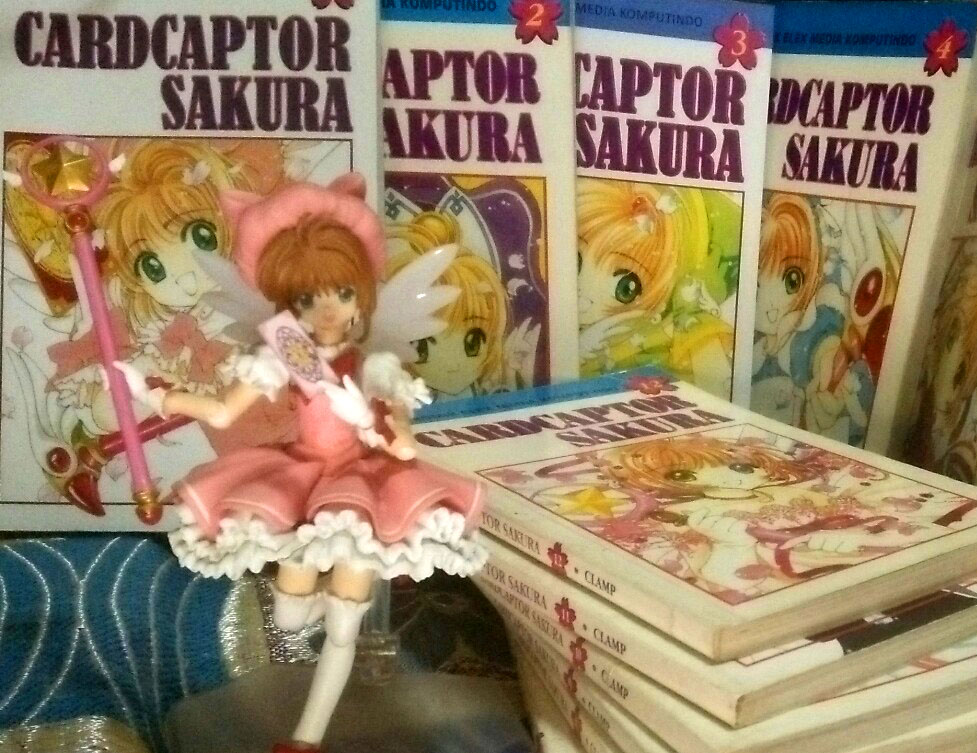Before Cardcaptor Sakura: Clear Card began airing, I decided to re-read the whole of the original Cardcaptor Sakura manga right before 2017 came to a close. Elex Media, which had published the shoujo manga in Indonesia during its heyday, has been re-releasing the series in 2017 as well; and a domestic TV channel INTV is also re-airing the anime. So, all in all, it’s a good time to look back at what makes this magical girl series charming.
In Cardcaptor Sakura, we follow an elementary schoolgirl named Sakura Kinomoto, living with her father and older brother. When she found a mysterious book in the basement of their house, she accidentally released the magic cards created by the wizard Clow Read that were sealed within. The guardian beast of the cards, Keroberos, then tasked Sakura to recapture the cards back. Other than Kero-chan, Sakura was accompanied in her quest by her best friend and cousin Tomoyo Daidouji, and later, a descendent of Clow’s relative from Hong Kong, Syaoran Li, also came to the city in search for the Clow cards.
Created by the mangaka team CLAMP in 1996, Cardcaptor Sakura came on the heels of the hit and influential magical girl series Sailor Moon. Sailor Moon’s formula of having girls with special powers fighting the forces of evil akin to a sentai team has led to many magical girl series that came in its wake follows the same idea (with Pretty Cure being one of the most prominent title in this lineage, having a new series each year since 2004).
Cardcaptor Sakura also features some action elements, and CLAMP has been known for working in different genres and combine elements from different genres (Lamarre, 2009). But as I came to see it, it is not really a story of a fight against evil. In the first arc of the story, the cards are more like neutral forces that went out of control. Quite often, magical incidents involving the cards are presented as some kind of puzzle that needs to be solved by understanding the nature and condition of the card. And then Eriol, who was initially presented like a villain of the “Sakura Card” arc, was eventually revealed to have been testing and helping Sakura in growing into her role as the new caretaker of the cards.

If the story of isn’t really about fighting evil, than what kind of story does Cardcaptor Sakura actually has? Overall, the story is concerned in many ways, with the the relationships of the characters and their feelings. And that makes sense if we consider some other perspectives about magical girl stories and shoujo manga. Consider what the producers of 80s magical girl anime Minky Momo and Creamy Mami, Toshihiko Sato and Yuji Nunokawa, have to say about their works, for instance. In their views, magical girls like Minky Momo and Creamy Mami offer a different approach to the world, who, rather than defeating enemies through force to resolve conflict, help people in living in the world through kindness (Galbraith, 2014). Regarding shoujo manga, Matt Thorn (2001) has asserted that they are “first and foremost about interpersonal relationships,” which may vary from heterosexual romance to boys’ love, and emphasises on feelings and moods.

As could be expected from a shoujo manga, Cardcaptor Sakura takes us up close to the characters’ feelings in relation to other characters, as interactions between them form, grow, or change. We are familiarized with the characters lives through their interactions in ordinary, daily life situations, such as chatting at school, exchanging gifts, cooking, going to a festival, and so on. And even the magic elements of the story are also weaved into the relationships, as in some cases, the magical incidents involving the cards are connected to emotional or relationship troubles that some of the characters were having. And there are even moments where Sakura used the power of the cards not to fight anything, but to present some kind gestures to others, such as to make a rainbow as a form of gratitude or to illuminate a festival during a power outtage.

Thus, as Sakura went through her quest or just interacted with others, she came to know more about people around her and also more about herself. And in the process, she helped others to understand themselves and each other more, and so did Sakura herself was helped to understand others and herself more. From Sakura and Syaoran gradually warming up to each other and recognizing their mutual feelings, to Sakura’s father receiving acceptance from his in-laws through their shared love for Sakura and her late mother, and many more; they brought together the characters into an environment supported by kindness.

To be continued on the next page







